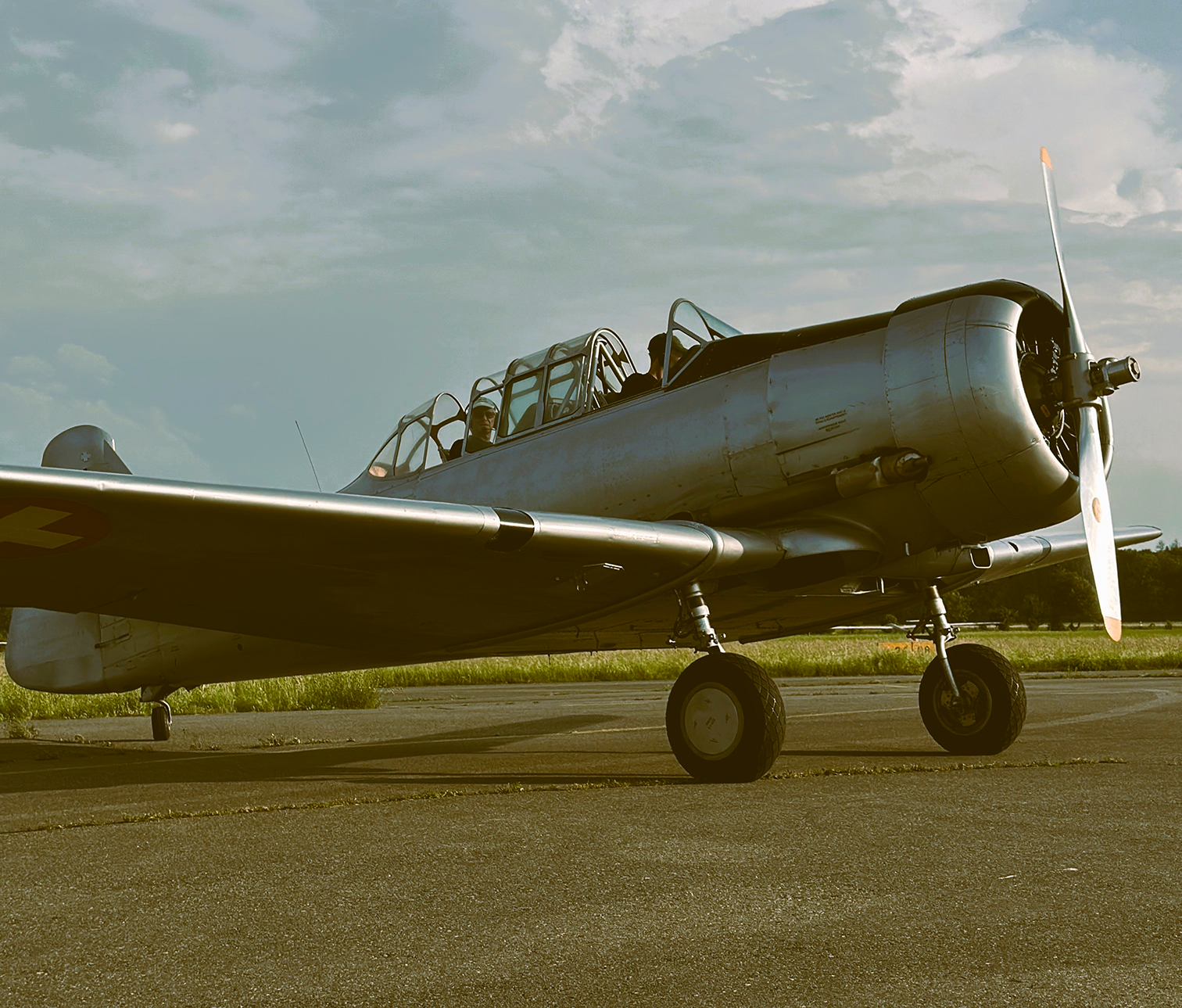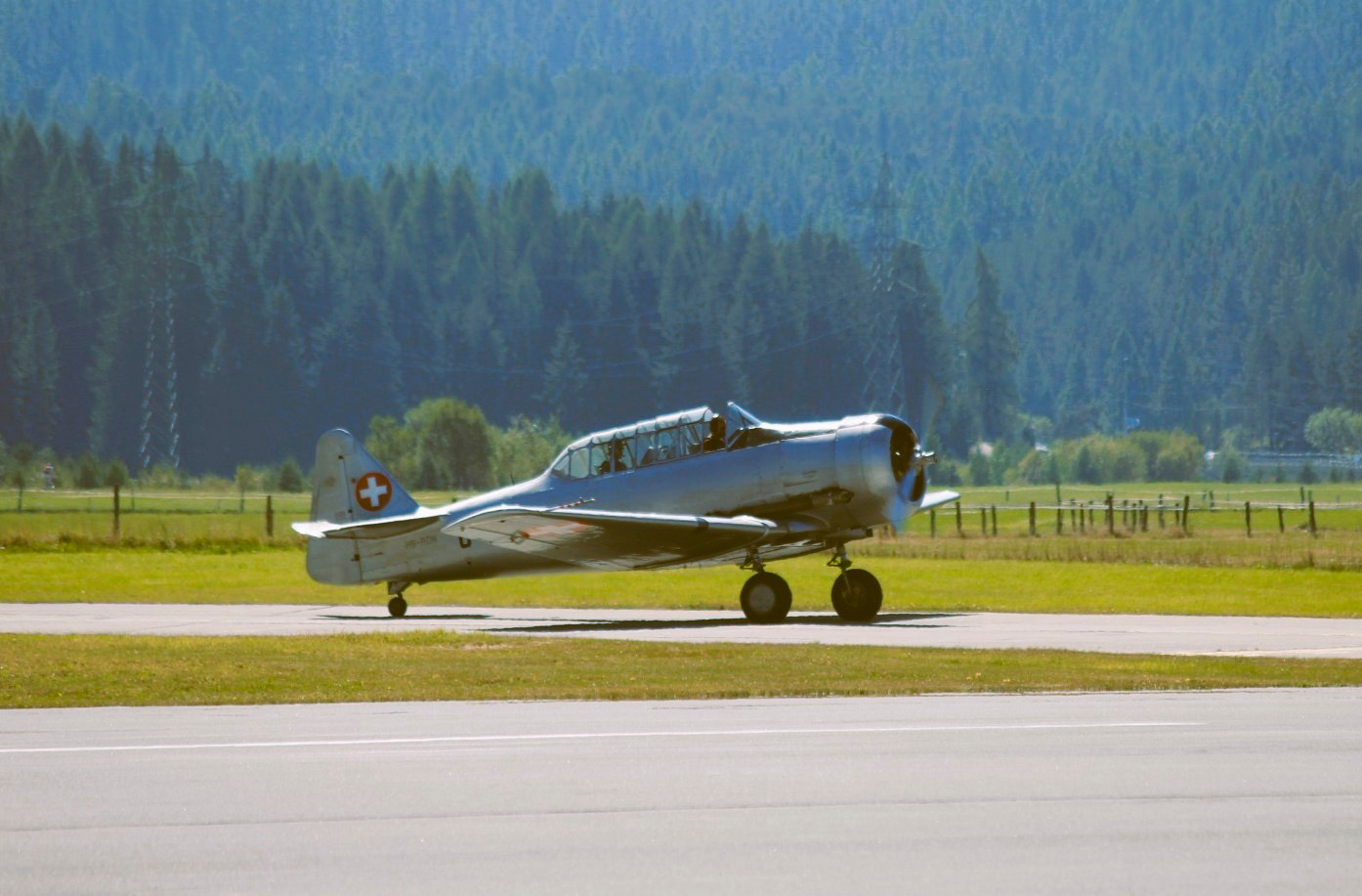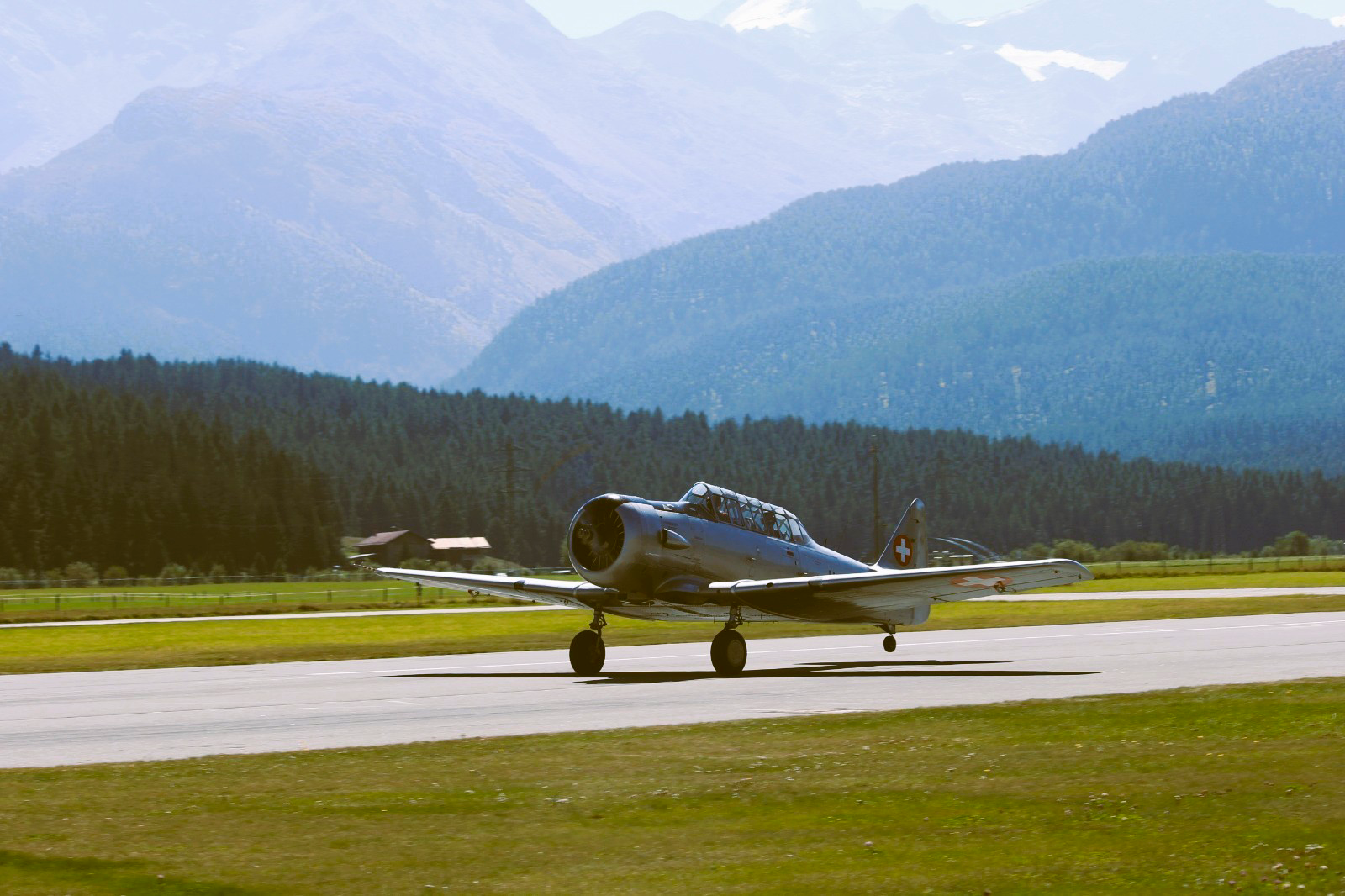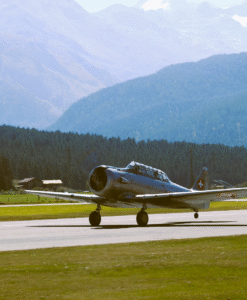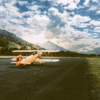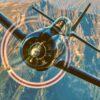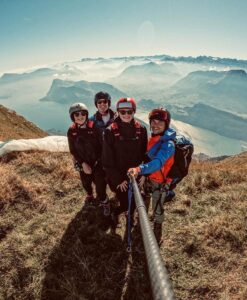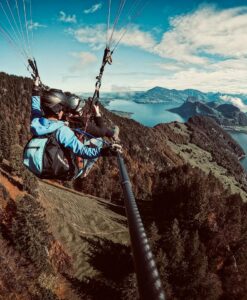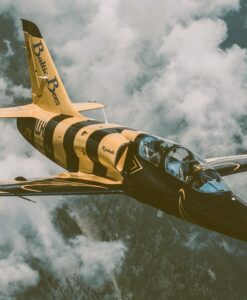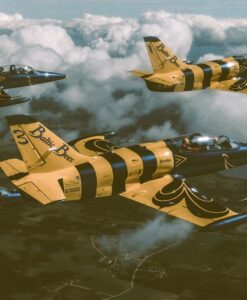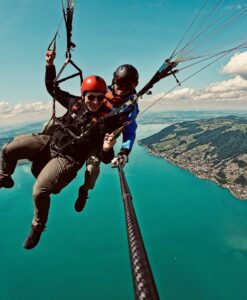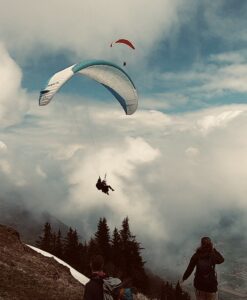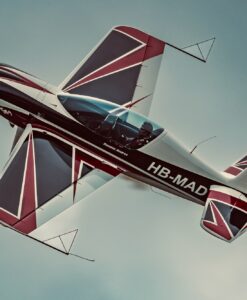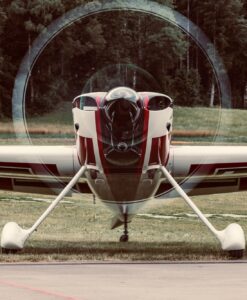Your flight in the AT-16/T-6 from Birrfeld
750.00 CHF – 1'220.00 CHF
A flight in the North American AT-16 Harvard from Birrfeld is far more than just a sightseeing flight – it's an impressive immersion into aviation history. The legendary American military trainer from the 1940s stands for avionic precision, powerful sound, and a nostalgic feeling of flying. The deep, throaty roar combined with the rhythmic rumble of the 9-cylinder radial engine. The classic vintage cockpit atmosphere. The manual retractable landing gear, which requires considerable effort. The imposing presence of the aircraft. A day you won't forget. After taking off from Birrfeld, the diverse panorama of the Swiss Mittelland opens up – rolling hills, shimmering rivers, and charming villages appear picture-perfect from the air.
North American AT-16 Harvard II – The legend lives on!
Immerse yourself in the golden era of aviation: Take a vintage sightseeing flight in the North American AT-16 Harvard II, nicknamed the "Pilot Maker." After decades of service, this former Swiss Air Force AT-16 was completely restored by Max Vogelsang at the Dübendorf Aviation Museum, undergoing thousands of hours of restoration and now shines in its former glory. A true gem. Upon request, your pilot can also fly aerobatic maneuvers with you.
Flight characteristics AT-16 Harvard
5 reasons for your AT-16 flight from Birrfeld
Flying in a true legend
The North American T-6 Texan family—which includes the AT-16 Harvard II—was a military training aircraft in the Western world for decades. The T-6 was designed to mimic the characteristics of high-performance aircraft and provide pilots with experience in handling retractable landing gear, radial engines, and power management. Climb aboard and experience authentic aviation history up close!
Powerful sound & real warbird feeling
The powerful sound of the radial engine, the vibration of the rudder – you'll feel every movement here. An experience for all the senses!
You decide how wild it gets
From a leisurely sightseeing flight to spectacular aerobatic maneuvers such as loops or rolls – everything is possible, according to your wishes.
Breathtaking scenery
The start in Birrfeld offers views of the Mittelland, the Alps and, if the weather is good, even as far as the Jura – a picture-perfect panorama.
Personal care & unforgettable memories
Experienced pilots, individual arrangements and real passion make your flight not only safe but also particularly personal.
The North American T-6 Texan family—which includes the AT-16 Harvard II—was a military training aircraft in the Western world for decades. The T-6 was designed to mimic the characteristics of high-performance aircraft and provide pilots with experience in handling retractable landing gear, radial engines, and power management. Climb aboard and experience authentic aviation history up close!
The powerful sound of the radial engine, the vibration of the rudder – you'll feel every movement here. An experience for all the senses!
From a leisurely sightseeing flight to spectacular aerobatic maneuvers such as loops or rolls – everything is possible, according to your wishes.
The start in Birrfeld offers views of the Mittelland, the Alps and, if the weather is good, even as far as the Jura – a picture-perfect panorama.
Experienced pilots, individual arrangements and real passion make your flight not only safe but also particularly personal.
Customer voice

The sound of the engine is simply amazing! It was a lot of fun.
Questions & Answers about the AT-16 flight
When do flights take place?
Flights take place year-round, weather permitting, but preferably from spring to fall by arrangement. In winter, flights are also possible from Bleienbach airfield—the AT-16's winter base.
Where are we flying to?
That's entirely up to you. Your flight will be discussed and planned during the briefing. Your pilot will, of course, have some great tips for you!
What is the process?
First, you'll get a chance to sniff around and marvel at this impressive vintage military trainer. You'll be amazed by the imposing presence of this classic warbird. Next, you'll be briefed and put together your very own flight program. You'll then be prepared for the vintage aircraft sightseeing flight, and after a warm-up, it's time to take to the skies! After the flight, there'll be time for photos and a relaxed chat with your pilot.
How long does it take in total?
Add an hour to the actual flight time. It's also up to you. Of course, you're welcome to chat with the pilot about your unforgettable flight, take photos together, or invite him for a drink in the airport restaurant.
Do you do aerobatics in the AT-16?
Yes, simple aerobatics such as rolls and loops will be possible. Your highly experienced pilot will ensure your AT-16/T-6 flight is unforgettable. He will tailor the flight program for you, taking your wishes into account.
Can friends or family come to the airfield?
Of course! Your loved ones are welcome at the airfield to accompany you during flight preparation, the briefing, takeoff, and finally, the landing. Just watching is a real treat! During the flight, your companions can enjoy a coffee in the airfield restaurant – and marvel at the AT-16's takeoff and landing with the best view.
Can I take photos or videos?
You are allowed to take photos and videos before and after the flight free of charge. Videos during the flight can be bookedTo do this, make sure to add the video option when booking your flight.
Who is my pilot?
And here too: As with the AT-16, pilot Max Vogelsang is a very well-known face in the Swiss aviation scene. He has flown countless models, starting with gliders, and later became known for landing his P-51 Mustang in Birrfeld. And then, of course, there are his well-known Votec in-house productions. Votec co-owner Florian is also very active in flying, and is also an excellent aerobatic pilot.
What is the story behind this AT-16?
Max Vogelsang, an entrepreneur and pilot from Wohlen, known above all for his ingenious Votec aerobatic aircraft (can also be flown at GoAviator, click on the link!) has completely restored an AT-16 Harvard II B, which had previously been in a desolate condition at the Dübendorf Aviation Museum. After over 7,000 hours of work and support from family and friends, the aircraft with the registration U-323 has been restored to its former glory. The maiden flight took place successfully at Birrfeld Airfield and made a great impression on spectators. The AT-16 Harvard II B is part of the famous T-6 Texan family. Originally, 1,200 examples of this type were built in Canada in 1942 for the US Air Force, where they were used to train fighter pilots during World War II. After the war, some of these aircraft came to Europe and also to Switzerland, where they were used successfully for blind flying training by the Air Force for 20 years from 1949. Many of these aircraft were later scrapped, but some found unusual uses, such as in film productions. The restored AT-16 received modern disc brakes and a reconditioned engine from the USA, and its weight was reduced by removing unnecessary parts. Vogelsang mastered the maiden flight with his co-pilot Christian Aegerter and even dared to perform a roll in the clouds. The flight was met with enthusiastic applause. We are proud to now offer this aircraft for private flights.
Can I learn more about the North American AT-16 Harvard/T-6 Texan?
A staggering 15,495 units of the T-6 Texan were produced by North American Aviation. Its first flight took place shortly before the outbreak of World War II, on September 28, 1938. It was primarily a training aircraft, but could also be armed with bombs and machine guns. It was widely used by the US Air Force and US Navy. The maximum speed of the AT-16 is 335 km/h.
The Swiss North American AT-16 Harvard II B was launched simultaneously with the P-51D Mustang from surplus stocks of the Canadian Air Force. After a comprehensive overhaul of the airframe and engine, the AT-16 was built by the Dutch companies Aviolanda and Fokker. For 20 years, 40 AT-16s played a central role in the blind flight training of Swiss Air Force pilots. With the introduction of the Pilatus P3-03/05, which was already being used in flight schools for blind flight training, the AT-16 became increasingly obsolete. From 1968 onwards, extensive maintenance work was required, including the replacement of fatigued parts. These circumstances led to the cessation of operations and the complete retirement of the AT-16 fleet. Two aircraft and four engines were retained as exhibits. The remaining engines, propellers, and engine mounts were acquired by an American aircraft maintenance company. These were transported to Dallas, Texas, where they were used in crop dusting aircraft.
Operating the T-6 Texan's landing gear requires a bit of manual effort from the pilot! Unlike modern aircraft with fully automatic systems, the T-6 featured a hand-crank mechanism for extending and retracting the gear. This meant the pilot had to turn a crank several times to retract or extend the gear. This was strenuous, especially during intense training sessions or combat scenarios that required quick reactions. While reliable, the manual system required concentration and coordination, as the pilot had to operate other controls simultaneously. This allowed the pilots to learn the importance of multitasking and remaining calm under pressure. It is a testament to the skill and resilience of the aviators who trained on this legendary aircraft.
What is the story behind this AT-16?
Max Vogelsang, an entrepreneur and pilot from Wohlen, known above all for his ingenious Votec aerobatic aircraft (can also be flown at GoAviator, click on the link!) has completely restored an AT-16 Harvard II B, which had previously been in a desolate condition at the Dübendorf Aviation Museum. After over 7,000 hours of work and support from family and friends, the aircraft with the registration U-323 has been restored to its former glory. The maiden flight took place successfully at Birrfeld Airfield and made a great impression on spectators. The AT-16 Harvard II B is part of the famous T-6 Texan family. Originally, 1,200 examples of this type were built in Canada in 1942 for the US Air Force, where they were used to train fighter pilots during World War II. After the war, some of these aircraft came to Europe and also to Switzerland, where they were used successfully for blind flying training by the Air Force for 20 years from 1949. Many of these aircraft were later scrapped, but some found unusual uses, such as in film productions. The restored AT-16 received modern disc brakes and a reconditioned engine from the USA, and its weight was reduced by removing unnecessary parts. Vogelsang mastered the maiden flight with his co-pilot Christian Aegerter and even attempted a roll in the clouds. The flight was met with enthusiastic applause. We are proud to now offer this aircraft for private flights. Simple aerobatic maneuvers are also possible.
Tell me more about the manufacturer North American Aviation.
North American Aviation (NAA) was a major American aerospace company that designed and built several notable aircraft and spacecraft. North American Aviation's most famous products included the T-6 Texan trainer (which includes the AT-16), the legendary P-51 Mustang fighter, the B-25 Mitchell bomber, the F-86 Sabre jet fighter, the X-15 rocket plane (over Mach 7!), the Mach 3 XB-70 Valkyrie bomber, the B-1 Lancer supersonic bomber (along with the B-2 and B-52, one of the USAF's three strategic bombers), the Apollo Command and Service Module, the second stage of the Saturn V rocket, and the Space Shuttle orbiter. Through a series of mergers and divestitures, North American Aviation became part of North American Rockwell, which later became Rockwell International and is now part of Boeing.
Flights take place year-round, weather permitting, but preferably from spring to fall by arrangement. In winter, flights are also possible from Bleienbach airfield—the AT-16's winter base.
That's entirely up to you. Your flight will be discussed and planned during the briefing. Your pilot will, of course, have some great tips for you!
First, you'll get a chance to sniff around and marvel at this impressive vintage military trainer. You'll be amazed by the imposing presence of this classic warbird. Next, you'll be briefed and put together your very own flight program. You'll then be prepared for the vintage aircraft sightseeing flight, and after a warm-up, it's time to take to the skies! After the flight, there'll be time for photos and a relaxed chat with your pilot.
Add an hour to the actual flight time. It's also up to you. Of course, you're welcome to chat with the pilot about your unforgettable flight, take photos together, or invite him for a drink in the airport restaurant.
Yes, simple aerobatics such as rolls and loops will be possible. Your highly experienced pilot will ensure your AT-16/T-6 flight is unforgettable. He will tailor the flight program for you, taking your wishes into account.
Of course! Your loved ones are welcome at the airfield to accompany you during flight preparation, the briefing, takeoff, and finally, the landing. Just watching is a real treat! During the flight, your companions can enjoy a coffee in the airfield restaurant – and marvel at the AT-16's takeoff and landing with the best view.
You are allowed to take photos and videos before and after the flight free of charge. Videos during the flight can be bookedTo do this, make sure to add the video option when booking your flight.
And here too: As with the AT-16, pilot Max Vogelsang is a very well-known face in the Swiss aviation scene. He has flown countless models, starting with gliders, and later became known for landing his P-51 Mustang in Birrfeld. And then, of course, there are his well-known Votec in-house productions. Votec co-owner Florian is also very active in flying, and is also an excellent aerobatic pilot.
Max Vogelsang, an entrepreneur and pilot from Wohlen, known above all for his ingenious Votec aerobatic aircraft (can also be flown at GoAviator, click on the link!) has completely restored an AT-16 Harvard II B, which had previously been in a desolate condition at the Dübendorf Aviation Museum. After over 7,000 hours of work and support from family and friends, the aircraft with the registration U-323 has been restored to its former glory. The maiden flight took place successfully at Birrfeld Airfield and made a great impression on spectators. The AT-16 Harvard II B is part of the famous T-6 Texan family. Originally, 1,200 examples of this type were built in Canada in 1942 for the US Air Force, where they were used to train fighter pilots during World War II. After the war, some of these aircraft came to Europe and also to Switzerland, where they were used successfully for blind flying training by the Air Force for 20 years from 1949. Many of these aircraft were later scrapped, but some found unusual uses, such as in film productions. The restored AT-16 received modern disc brakes and a reconditioned engine from the USA, and its weight was reduced by removing unnecessary parts. Vogelsang mastered the maiden flight with his co-pilot Christian Aegerter and even dared to perform a roll in the clouds. The flight was met with enthusiastic applause. We are proud to now offer this aircraft for private flights.
A staggering 15,495 units of the T-6 Texan were produced by North American Aviation. Its first flight took place shortly before the outbreak of World War II, on September 28, 1938. It was primarily a training aircraft, but could also be armed with bombs and machine guns. It was widely used by the US Air Force and US Navy. The maximum speed of the AT-16 is 335 km/h.
The Swiss North American AT-16 Harvard II B was launched simultaneously with the P-51D Mustang from surplus stocks of the Canadian Air Force. After a comprehensive overhaul of the airframe and engine, the AT-16 was built by the Dutch companies Aviolanda and Fokker. For 20 years, 40 AT-16s played a central role in the blind flight training of Swiss Air Force pilots. With the introduction of the Pilatus P3-03/05, which was already being used in flight schools for blind flight training, the AT-16 became increasingly obsolete. From 1968 onwards, extensive maintenance work was required, including the replacement of fatigued parts. These circumstances led to the cessation of operations and the complete retirement of the AT-16 fleet. Two aircraft and four engines were retained as exhibits. The remaining engines, propellers, and engine mounts were acquired by an American aircraft maintenance company. These were transported to Dallas, Texas, where they were used in crop dusting aircraft.
Max Vogelsang, an entrepreneur and pilot from Wohlen, known above all for his ingenious Votec aerobatic aircraft (can also be flown at GoAviator, click on the link!) has completely restored an AT-16 Harvard II B, which had previously been in a desolate condition at the Dübendorf Aviation Museum. After over 7,000 hours of work and support from family and friends, the aircraft with the registration U-323 has been restored to its former glory. The maiden flight took place successfully at Birrfeld Airfield and made a great impression on spectators. The AT-16 Harvard II B is part of the famous T-6 Texan family. Originally, 1,200 examples of this type were built in Canada in 1942 for the US Air Force, where they were used to train fighter pilots during World War II. After the war, some of these aircraft came to Europe and also to Switzerland, where they were used successfully for blind flying training by the Air Force for 20 years from 1949. Many of these aircraft were later scrapped, but some found unusual uses, such as in film productions. The restored AT-16 received modern disc brakes and a reconditioned engine from the USA, and its weight was reduced by removing unnecessary parts. Vogelsang mastered the maiden flight with his co-pilot Christian Aegerter and even attempted a roll in the clouds. The flight was met with enthusiastic applause. We are proud to now offer this aircraft for private flights. Simple aerobatic maneuvers are also possible.
More customer testimonials

Clearly the best way to spend a Sunday afternoon. Now let's move on to the Mustang!

Absolutely breathtaking! I felt like a bird flying over the Alps.

I always knew this was Pierre's dream. Thank you for making this possible!
Related products
Highlights
Biplane
Bremgarten
acrobatics
fighter jets
acrobatics
acrobatics
Habsheim
aerobatics

